
Ethan Stark-Miller
Victor Andrews, 32, on a morning commute from where he lives in Clinton Hill Brooklyn to 23rd Street in Manhattan. Andrews is blind and faces challenges using the subway system.*Most New Yorkers rely on the subway to get around the city everyday, but Richard Van-LaRusso can’t. This is because he has a visual impairment that makes it very challenging for him to travel on the subway.
“I’ve always been legally blind, had vision in my right eye. But about 10 years ago, my vision started getting very blurry,” Van-LaRusso said. ”And since that time, it’s kind of been a gradual decrease.”
When Vann-LaRusso does take the subway, his normal commute is from where he lives in Midwood Brooklyn to his internship at the Brooklyn Center for the Independence of the Disabled (BCID) in Downtown Brooklyn. Vann-LaRusso, 67, encounters challenges from the moment he walks into the Avenue M elevated subway station on the Q line – the station closest to his home.
Because of Vann-LaRusso’s low vision, it’s hard for him to use the vending machines to refill his MetroCard and check his card’s balance. MetroCard vending machines do have accessibility features for blind and visually impaired people, like jacks for headsets to deliver audio instructions and braille*, but Vann-LaRusso didn’t know about these features and wasn’t trained on how to use them. Instead he goes to the station booth and asks the attendant for help.
Then, Vann-LaRusso has to travel up two flights of stairs to the platform, where he has to contend with crowds flowing in both directions. Once Vann-LaRusso reaches the platform, he struggles with finding where the train car doors open.
Vann-LaRusso also doesn’t use the subway often because he has trouble navigating routes he’s unfamiliar with. This is because larger stations have complicated layouts and don’t have clear directional information for people with visual impairments.
Victor Andrews, a blind Brooklyn resident, said he barely uses the subway outside of his commutes to work because service information is often not provided in accessible formats.
“When you get to the train station, the train doesn’t work and you don’t know that until you get there,” said Andrews. “They’re supposed to have signs up, but if they’re not in braille or in audio how am I supposed to know what’s going on?”
Many blind and visually impaired, deaf and cognitively disabled New Yorkers face challenges when using the subway. A large portion of the system is still missing key accessibility features that would make the subway usable for these groups. And while this problem is on the Metropolitan Transportation Authority’s (MTA) radar – the MTA launched a pilot program in October to address it – the agency still has no clear plan or timeline for quickly expanding these features to the entire system.
A lack of access
The Americans with Disabilities Act (ADA), a landmark piece of legislation that banned discrimination on the basis of disability, was signed into law on July 6th 1990 – almost 30 years ago. That year, the Department of Justice published the Title II and Title III sections of the law – which specified regulations for state and local governments, as well as, public accommodations and commercial facilities respectively.
While the ADA has made life considerably better for those with disabilities over the past 29 years, discrimination against these individuals still exists. Part of this discrimination is a lack of access to public transit.
An inaccessible subway makes it difficult for people with disabilities to get to interviews, vocational training sessions and their jobs on time. Thus discrimination in these networks can be a key barrier to employment for those with disabilities.
Since the ADA requires stations to be accessible for wheelchair users, people usually see station accessibility in terms of installing elevators and ramps. But there is more to station accessibility than these features.
However, the majority of New York City’s subway system still doesn’t even comply with the requirement for elevators and ramps, a form of accessibility that’s often called vertical access. Only 119 out of New York City’s 472 subway stations, or 25 percent, are accessible according to ADA guidelines – this is not including stations on the Staten Island Railway.
When compared to other major American cities like Boston or Chicago, New York City’s subway system is far less vertically accessible. According to a report from the organization Transit Center, 71 percent of Boston’s and 69 percent of Chicago’s subway stations are accessible. And both cities have plans and timelines for reaching 100 percent accessibility. Additionally, New York City trails way behind Washington, D.C. and Los Angeles, which both have 100 percent accessible subway systems according to the report.
While vertical access is crucial to the livelihoods of many disabled individuals, people with other disabilities like blindness or low vision, deafness and cognitive disabilities also have a hard time navigating the New York City subway system and need accessibility features of their own.
Lots of signage they can’t see

Ethan Stark-Miller
Andrews uses his cane to navigate walking down the steep staircase to the train platform in the Clinton-Washington Avenues G train station.Blind and visually impaired commuters mainly face challenges with safety and the conveyance of service information. These individuals require alternate ways of warning them of dangerous areas where they could fall, like platform edges and staircases. This is mainly achieved with high contrast tactile strips – those bumpy yellow rectangles – along platform edges and on the first and last steps of stairwells.
James Weisman, CEO of the United Spinal Association and a longtime disability lawyer, said the ADA requires these strips be installed but only in key stations, which are usually major hubs and transfer points. Weisman said the MTA has adopted a policy of adding platform edge strips to non-key stations as well, but there are still many stations without them.
“We know that in some stations, they either don’t exist or they’re not really appropriate,” said Joe Rappaport, the executive director of BCID.
Meredith Daniels, the MTA’s media liaison, said 350 stations in the system have platform edge strips. Meaning that 122 stations still don’t have this crucial ADA required safety feature. Susan Dooha, executive director of the Center for Independence of the Disabled, NY (CIDNY), said there have been cases where both her employees and people her organization works with have fallen on the subway tracks because of missing platform edge strips.
Station navigation and service information is also often inaccessible to blind and visually impaired people.
“There’s lots of signage that they can’t see,” said Weisman. “It’s been like that for 100 years.”
Weisman said the ADA requires that all information on public transit be provided in accessible formats for people with sensory issues. Vann-LaRusso often has trouble navigating complicated subway stations and routes because signage and service information is inaccessible.
“The announcements need to be clearer,” said Vann-LaRusso. “Having some tactile signs or an arrow leading in a direction, to the R train for example.”
Because of the challenges that Vann-LaRusso identified, visually impaired people need signage that uses large fonts, high contrast colors and braille when appropriate. Also, they require information kiosks to be accessible, with jacks to plug in headphones and braille on the keypads.
Additionally, audible announcements are a crucial way to make service information available for the blind and visually impaired. Accessible architect Chris Downey, who manages the design firm Architecture for the Blind, said people with limited to no sight become far more dependent on the acoustic environment.
“It’s something that’s classically poorly done in subways,” said Downey. “You have to have the ability to hear it, for the announcement to be tied to an ambient noise sensor so that its volume can rise if the ambient noise is loud.”
An ambient noise sensor would boost the volume of announcements if the ambient noise in the station is too loud. Also, Downey said announcements should be repeated more than once, so people have more than one chance to hear their content in a noisy station.
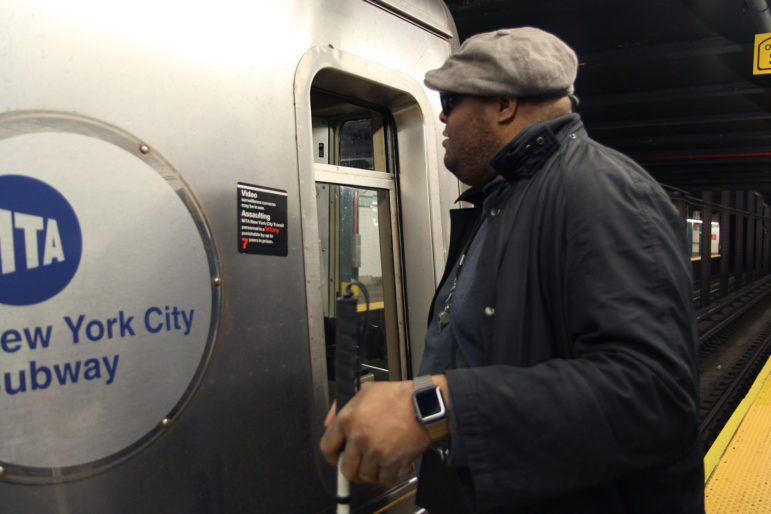
Ethan Stark-Miller
Victor Andrews talking to the G-Train Motorman before boarding the train. He does this after feeling around the front of the G-Train with his cane to find the door.‘What did they say?‘
The deaf and hard of hearing community faces challenges of their own when it comes to safely navigating their commutes. Dennis Martinez, who is deaf and works at the Harlem Independent Living Center, said the biggest challenge he faces while riding the subway is when train operators announce delays or emergency situations.
“When I’m riding the train and it stops, I can feel them speaking, like I feel the vibration, but I’m clueless as to why we stopped,” Martinez said through an interpreter. “We could be sitting there for quite a long time. And so I have to text a hearing person next to me and say, ‘what did they say?’ And then they’ll tell me.”
Martinez said there are a couple of ways the MTA could be addressing this issue. The first is to have closed captioning scroll on a screen to accompany the train operator’s announcement over the intercom. Newer trains provide this feature with regular service announcements, but not with emergency announcements and these aren’t available on older trains. Providing text read-outs of announcements is also required by the ADA.
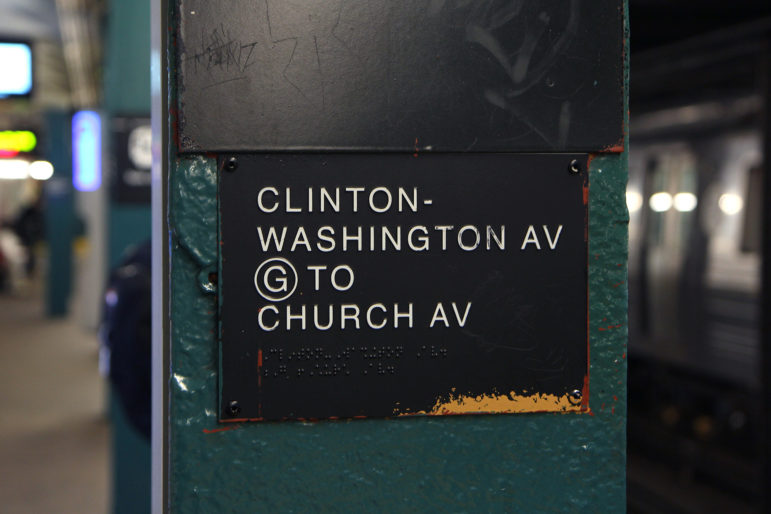
Ethan Stark-Miller
A Clinton-Washington Avenues Station sign with braille and raised tactile letters for blind and visually impaired customers like Andrews.“Everything in audio has to have an observable read-out, “ Weisman said. “If the conductor is making an announcement on the train, there should be a way that people with hearing impairment can read it.”
And the second, Martinez said, is to have more MTA staff who are trained in basic sign language who can communicate this information to deaf individuals.
Then, according to Dooha, the main challenge for people with cognitive disabilities is navigating subway stations with complicated layouts. Dooha, who has a brain injury, said that navigating the Union Square station near her office is still a challenge for her despite using the station nearly everyday for the past 21 years.
“I have to say that finding my way out of the station, once I’m underground is a crapshoot for me, I cannot consistently follow directions to an exit that I need to get out at,” Dooha said. “There’s not enough directional guidance for me to be able to get out at the Broadway staircases versus the ones along Union Square West or others.”
The best way to improve this issue, Dooha said, is to have clearer directional guidance markers – often called wayfinding markers – throughout train stations. This can be achieved by strong demarcating lines that guide passengers to the exits and specific trains. Another option is to install beacon wayfinding technology that works with peoples’ smartphones. The Boston and Austin transit authorities are both using beacon wayfinding technology to make their systems easier to navigate.
The MTA experiments with solutions
While these accessible features continue to be absent throughout many parts of the subway system, New York City Transit – the subdivision of the MTA that runs the city’s subways and buses – is aware of the problem and launched a pilot program in October to address it. New York City Transit is testing several accessible features in the Jay Street-MetroTech station in Downtown Brooklyn, which it’s calling the Accessible Station Lab. Jay Street-MetroTech is a major transit hub and boasts the second highest ridership in the borough with 42,274 weekly riders in 2018.
Alex Elegudin, New York City Transit’s Accessibility Chief, said the agency chose the features being tested in the Accessible Station Lab by consulting its Accessibility Advisory Committee and doing focus groups with various sub-groups of the disabled community.
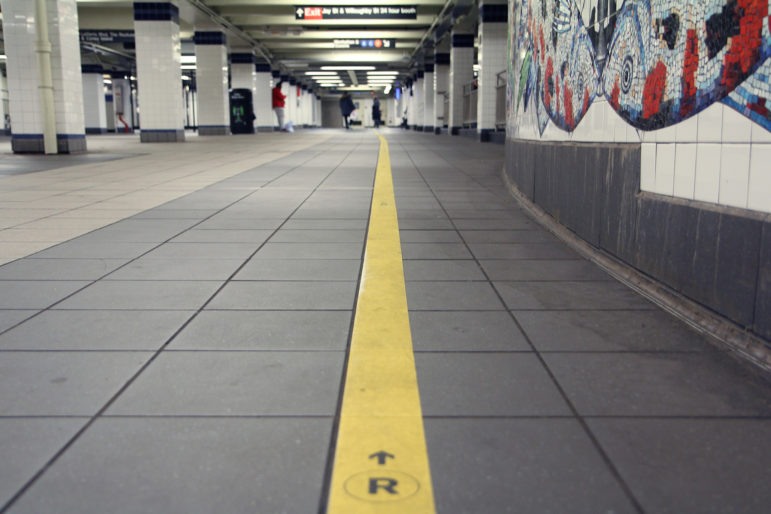
A colorful wayfinding strip leading to the R-Train in the Jay Street MetroTech Station. 
Wall tiles that work with the app NaviLens in the Jay Street MetroTech Station. This app is designed to help blind and visually impaired people navigate train stations. 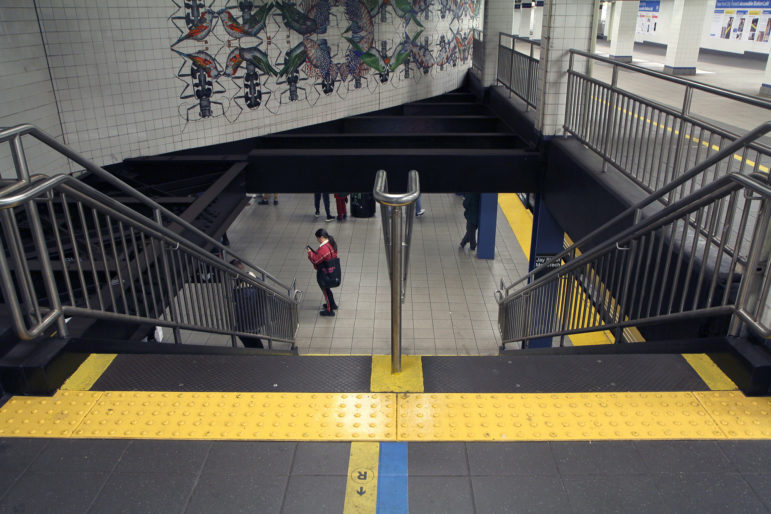
Tactile stair warning strips in the Jay Street MetroTech Station. These accessible features are designed to help blind and visually impaired people find the stairs. 
Tactile guide strips and colorful wayfinding strips in the Jay Street MetroTech Station. These accessible features are designed to help blind and visually impaired and cognitively disabled people navigate train stations. They’re being tested in the MTA’s Accessible Station Lab pilot program this fall.
“We took their feedback early on in terms of what to try and what not to try,” Elegudin said. “We vetted every need with the community.”
The features the transit agency is testing include a number of smartphone apps designed to help people who are blind and visually impaired, as well as, those with cognitive disabilities. One such app called NaviLens, allows people with sight impairments to access sign information through audio. Another app being tested is MagnusCards, which gives cognitively disabled people detailed instructions on traveling the subway through a series of how-to guides. According to Rappaport — the executive director of BCID — though, this excludes people who can’t afford smartphones.
In addition to the apps, the Accessible Station Lab is also testing out a number of navigational floor treatments and accessible signs. These floor treatments include colored wayfinding strips that are intended to guide passengers with low vision and cognitive disabilities around stations. Additionally, there’s tactile guideway strips, similar to those along the platform edge, to help blind customers using a cane find their way around. Andrews finds these tactile guideways helpful.
“Tactile guideways guide you to where the map is, to where the audio is, to where the braille is, so you know how to walk along the corridor,” said Andrews.
And tactile strips have also been placed on the first and last steps of staircases as a safety warning to blind and visually impaired customers.
New York City Transit is testing an accessible feature for deaf and hard of hearing individuals in another location. The agency has installed a hearing loop in the Bowling Green station in Lower Manhattan to help those with hearing aids or cochlear implants hear service information more clearly. Elegudin also emphasized that the agency plans to use other methods for making announcements available to deaf people in the coming years.
“Every announcement that we make, whether it’s on a subway, whether it’s in a station, we’re trying to get it on a screen, to get it on an app, to get it in some kind of textual format,” Elegudin said.
Elegudin said his agency is using three methods for evaluating the effectiveness of the features being tested. The first is assessments performed by New York City Transit’s accessibility team, which includes tours and focus groups. Also included in this first method is feedback from the disabled customers that can be submitted through the Accessible Station Lab website.
“That’s going to be a big driver of our decision making, I believe,” Elegudin said.
The second method is a data driven analysis conducted by an outside consultant, which Elegudin said is an academic institution. For their final evaluation method they’ve enlisted the station staff to observe how the physical features are holding up under the daily wash routines and general wear that comes with a highly trafficked station.
A Jan. 5 MTA press release said the Accessible Station Lab has received a good amount of positive feedback.
“Initial feedback from customers and advocates affirms that many of the pilot features have great potential to make subway stations more accessible for riders of all abilities,” the press release said.
The release also included some positive quotes from advocates but didn’t share any quantifiable metrics for the feedback. New York City Transit said it will be accepting customer surveys through Jan. 17 and most of the accessible features will remain in the station through early 2020.
This train will be moving … sometime
Elegudin said New York City Transit currently doesn’t have a plan to expand these features out to rest of the subway system and didn’t give a specific time frame.
“For the entire system it’s going to take years,” Elegudin said. “We certainly would prioritize and try to get accessible stations. Specifically some stations done early where there’s a particular need.”
Elegudin said this means New York City Transit will be upgrading stations that are wheelchair accessible with the other types of accessibility features being tested in the pilot program, before the stations that aren’t accessible at all.
The MTA 2020-2024 Capital Program – the agency’s plan for budgeting out capital projects over the next four years – allocates more than $5.2 billion to accessibility upgrades and plans for making 70 more stations ADA accessible.

Ethan Stark-Miller
High contrast tactile platform edge strips to warn blind and visually impaired customers of the platform edge at the Clinton-Washington Avenues Station.“By 2029, over 50 percent of stations will be fully accessible,” said Daniels, the MTA’s media liaison, in an emailed statement. “The pace of investment will continue, with the goal of achieving maximum possible system-wide accessibility by 2034.”
But the MTA doesn’t make it clear in their plan whether this includes adding other accessible features besides those for wheelchair users. However, Elegudin said these features would be included when stations are upgraded to be wheelchair accessible under ADA guidelines.
Weisman, the accessibility lawyer, is cautiously optimistic that the MTA will make good on its plan to get all of this work done in five years.
“If you take an aggressive approach, like MTA is doing, which could be pie in the sky, who knows that they’ll ever get all this work done in five years, but that is what they’re saying,” Wiesman said.
But he emphasized that the MTA has to stay the course and consistently take an aggressive approach to accessibility in order to make the entire system accessible in about a decade.
“But it has to be everybody pushing, you have to have the money to do it, which is very hard to do in 10 or 12 years,” Weisman said. “But the work could get done.”
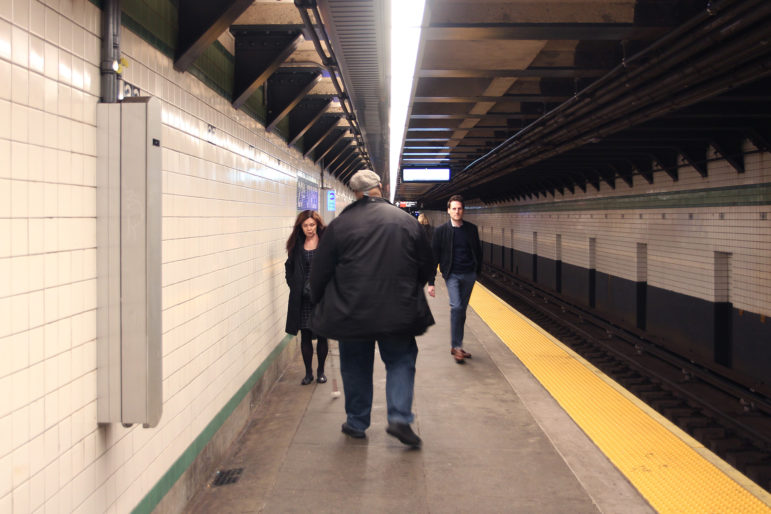
Ethan Stark-Miller
Andrews walks on a crowded platform at the 23rd Street Station as he heads for the exit. Many platforms in the subway system are narrow and often crowded, which can be challenging for blind and visually impaired people to navigate.Clarification: To correct a wording error that suggested a site Andrews visited for work was where he worked, the caption has been updated. Also, information was added about existing accessibility features on MetroCard vending machines.









7 thoughts on “Underground and Underserved: To Be Blind or Deaf and Ride the NYC Subway”
meanwhile in tiny holland
https://www.bbc.com/news/av/world-europe-43788197/how-dutch-stations-help-blind-travellers
FFS, get it together!
Nice article; generally quite thorough, except that there is no mention of the value of “universal design”. Features that aid people with disabilities also tend to benefit other consumer groups such as seniors, tourists, language-learners, etc.
Mr. Stark-Miller This piece is full of inaccurate information, and just sounds like a “pitty piece” for blind people . First off, Alpha Pointe is not located on 23rd Street in Manhattan, it is in Richmond Hills Queens. The apartment building Selis Manor, and VISIONS at Selis Manor is located on 23rd Street. Also, subway Metro Card machines do have headphone jacks (I just used one this morning). I am blind and have been traveling the subway for more than 30 years, and while it is not a perfect system, with the right type of training from a certified orientation and mobility instructor, most individuals with vision loss can navigate freely. Additionally, you should have interviewed a professional in the field of blindness and low vision, to get a perspective from someone who provides training to individuals with vision loss. Please do a better job to verify your information; this impacts your credibility as a hole.
Mr. Cush: We’ve clarified the fact issues you raised; thanks for bringing them to our attention. On your other points, Ethan Stark-Miller replies:
Hello, thank you for taking the time to read my story and for your feedback. I’m well aware of orientation and mobility training and how helpful it can be to people with vision loss who are traveling the subway. However, this story focuses on the structural barriers that the subway presents for people with vision loss and my reporting and interviews indicated that the system is far from perfect and can be massively improved. I felt that talking about the benefits of travel training would detract from the main point of the story, that the MTA has to do more to make the subway universally accessible. And this story is by no means the end of the conversation, there can be many more that highlight the importance of travel training to the independence of people with vision loss.
“Because of Van-LaRusso’s low vision, it’s hard for him to use the vending machines to refill his MetroCard and check his card’s balance. He has to go to the station booth and ask the attendant for help. ”
This part of the story makes no sense. As a disabled person who is registered with AAR (Access-A-Ride), that person is issued a free MetroCard.
There should not be any reason for Mr Van-LaRusso to be using a vending machine to refill or even pay for a MetroCard.
With the various organizations he has been involved with – why has he not been informed of the free MetroCard that he is entitled to?
Of course, Washington, DC,’s system is only 43 years old and Los Angeles’s even younger. Hence 100% accessibility. But somehow Boston is going to retrofit every station, and we can’t?
I like how you said that visually impaired people need braille on keypads and signs. I think a lot of people understand this and it blows my mind when public places don’t have these things. If we want our Country to be fair to everyone then we need to have braille signs put up everywhere.